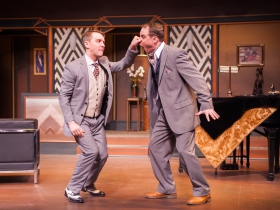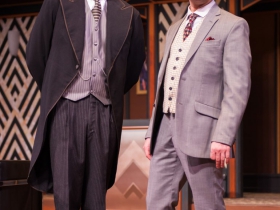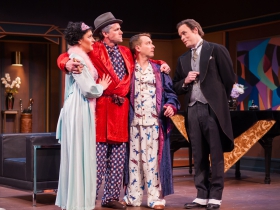Oh Jeeves, Why So Little Plot?
Chamber Theatre’s third production of the Jeeves trilogy runs merrily on empty.

(l-r): Chris Klopatek as Bertie, Steven M. Koehler as Knuckles, Anna Cline as Ruby. Photo by Paul Ruffolo.
Falling back on expert timing, the cast of Jeeves Takes a Bow carries us to nowhere on gossamer wings through May 3 in a production by the Milwaukee Chamber Theatre.
The skills with which props are traded, voices bellow and panicked bodies fly recklessly across the Cabot proscenium stage both amaze and distract us from so obvious and tiresomely repetitive devices.
A packed and uncommonly friendly opening night house at the Broadway Theater Center behaved as if the comedy wasn’t running merrily on empty — and for more than two hours of all brass and no flutes. To survive you have to carry an outsized affection for the Jeeves-Wooster stories and this cast’s precision antics.
There is a deserved initial ooh and aah for Rick Rasmussen’s Art Deco re-creation of posh Manhattan digs – the arena for the company to dart in and out of doorways and around sofas with Prohibition era Damon Runyon types. There’s also Kim Instenes’ effort to eke laughs from argyle, feathers and other costume touches and prop master Melissa Centgrals’ endless array of tossed glasses, cups, kerchiefs and knick-knacks. Would that such techniques were spent on at least the Marx Brothers and not secondhand Ritz Brothers.
This is the Milwaukee Chamber Theatre’s feeblest plunge of three into Jeeves land, a familiarity that doesn’t breed fondness.
Director Tami Workentin knows this cast can run, leap and hide with the best of them, so she’s scheduled almost impossibly adroit maneuvers of dishware exchanges and sprawling bodies, and employs Doug Vance’s lighting like a rim shot to punch home the climaxes. She helps the actors elaborate their gimmicks in temper tantrums or cowpoke clowning, each time hoping the sheer energy will keep us from noticing the inexplicable excuses.
You can’t help but admire that vaudevillian precision, but you also can’t help comparing it to far more purposeful outings by the leading talents, times when you didn’t see the wheels turning and felt sorry for the performers stuck on a treadmill. Such expertly done mechanical metronomics are basic to farce but as this production demonstrates can be a disservice to farce, which should engage the mind as well as the eyes and ears. This director and company have done that far better in the past.
Matt Daniels as Jeeves glides deftly, poses expertly and sneers perfectly but has few rationales for doing so. Nostalgia for former cleverness won’t cut it. Chris Kopatek’s Bertie uses his full range of physical comedy and scaling vocals, to the point we are watching for the next stunt that has nothing to do with the story or the original character. Seldom has a lazy wealthy British gadabout expended so much energy for so little so often.
Chase Stoeger as Bertie’s partner in stupidity, Binky, telegraphs his acrobatics more than I’ve seen before. With few opportunities in the script to demonstrate his genuine acting chops, Steven M. Koehler pushes past tolerance his Cagney-Raft impersonation of a dense gangster.
The ladies of the piece echo how actual talents can succumb to an overblown style. Anna Cline plays the Broadway doll as an annoyingly stentorian Adelaide, while we know that Kay Allmand will turn from Puritan spinster into speakeasy flirt — but with that transition vanishes all pleasure in her clipped delivery.
There is a saying in the ballet world that when the choreography is pedestrian, the best the dancer can do is “smile and bourree.” That’s what these actors are doing to hide that this is the time for Jeeves to take an exit, not a bow.
Dominique Paul Noth served for decades as film and drama critic, later senior editor for features at the Milwaukee Journal. You can find his blog here.
Jeeves Takes a Bow Gallery
Review
-
Eating Burmese in Bay View
 Dec 13th, 2025 by Cari Taylor-Carlson
Dec 13th, 2025 by Cari Taylor-Carlson
-
Casablanca Is a Milwaukee Success
 Nov 30th, 2025 by Cari Taylor-Carlson
Nov 30th, 2025 by Cari Taylor-Carlson
-
Oh, Those Witty 18th Century Brits
 Nov 24th, 2025 by Dominique Paul Noth
Nov 24th, 2025 by Dominique Paul Noth
Theater
-
Oh, Those Witty 18th Century Brits
 Nov 24th, 2025 by Dominique Paul Noth
Nov 24th, 2025 by Dominique Paul Noth
-
Skylight’s Holiday Show Is Lots of Fun
 Nov 16th, 2025 by Dominique Paul Noth
Nov 16th, 2025 by Dominique Paul Noth
-
Rep’s ‘Come From Away’ Is a Triumph
 Nov 10th, 2025 by Dominique Paul Noth
Nov 10th, 2025 by Dominique Paul Noth























You write that this play “carries us to nowhere on gossamer wings” (a very poetic phrase). I haven’t seen it, but the words of Wodehouse are strong, and it’s sad that the play relies on timing it carry it through, when the original work is brimming with the love of words. I saw Lettice And Lovage by Peter Shaffer last night and it shone brilliantly with the love of words created by Peter Shaffer!